If you are planning a trip to Israel and are trying to create an itinerary, this post will help you build the best one. Israel is such a fascinating country with so many unique places to visit, that it’s difficult to decide where to begin.
Table of Contents
- About this itinerary
- How Many Days to Spend in Israel
- Israel Itinerary – Best Places to Visit on a 2-Week Trip to Israel
- Day 1: Eilat & the Negev Desert
- Day 2: West Bank (Bethlehem, Jericho & Qasr el Yahud Baptismal Site)
- Day 3: the Judean Desert (Masada & the Dead Sea)
- Israel Itinerary Day 4 to 9: Jerusalem
- Day 10 & 11: the Sea of Galilee
- Israel Itinerary Day 12: Nazareth & Akko
- Day 13: Haifa & Caesarea
- Day 14 & 15: Tel Aviv & Jaffa
- Day 16: Fly back home
- When is the best time to visit Israel?
About this itinerary
I did a lot of research before our trip to Israel. Watched videos, read reviews and travel guides, but it’s not easy to find a good online itinerary for Israel.
Most websites I checked underestimate the amount of time you need to visit the different places in Israel. In this post I’ll try to give you a better idea about how long you’ll need for each of these destinations.
We toured Israel independently, driving ourselves around the country and stopping along the way at the different points of interest. There are many tour operators that offer guided tours throughout Israel. However, we believe that with a little preparation, you can visit all these sites on your own. So this itinerary is good for people who want to visit Israel independently.
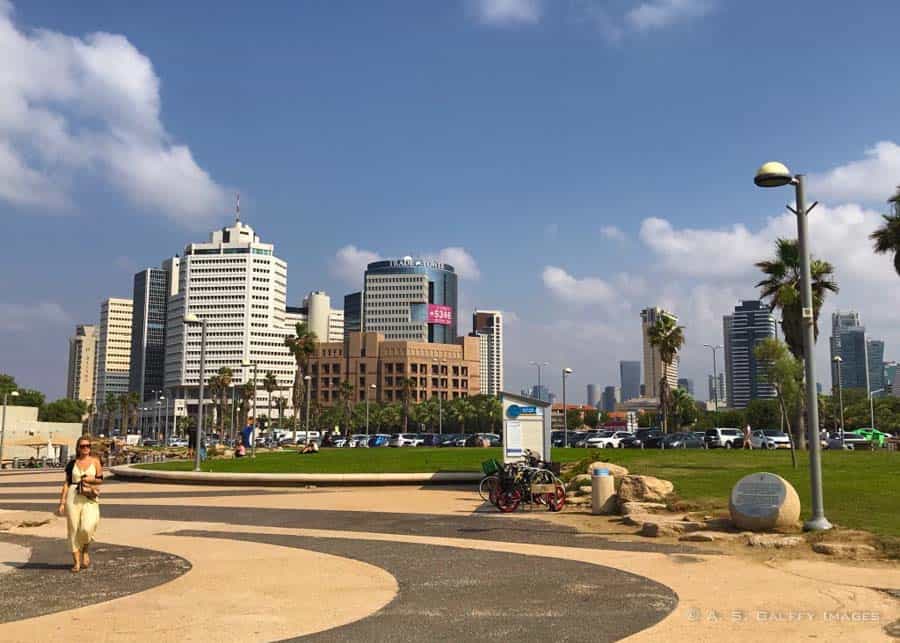
How Many Days to Spend in Israel
Deciding how many days to stay in Israel depends to a large extent on the purpose of your trip and your interests. If you are familiar with Israel’s fascinating history, you’ll probably want to visit all the archeological sites of biblical importance. In this case you’ll need a minimum of 14-16 days.
This itinerary is good have 14 or more days in Israel. If you only have 7 to 10 days, you may still be able to see some of the sites we visited in 16 days, but you’ll have very little time at each destination. So here are the most important sites to include in your tour:
Israel Itinerary – Best Places to Visit on a 2-Week Trip to Israel
Our journey started in Eilat, which is the southernmost city in Israel, close to the border with Jordan. We chose to start here because we also took a 5 day trip to Jordan before coming to Israel and crossed borders in Eilat. From Eilat we continued to the Negev Desert, the Dead Sea, Jerusalem, the Sea of Galilee, Akko, Haifa, and ended our trip in Tel Aviv.
Map for our trip to Israel
Day 1: Eilat & the Negev Desert
Eilat is a busy port and a beautiful resort town at the Red Sea, located on the Gulf of Eilat. The city is mainly famous for its beautiful scuba diving spots. When you see how clear the water is you understand why Eilat is so popular among divers and snorkelers.
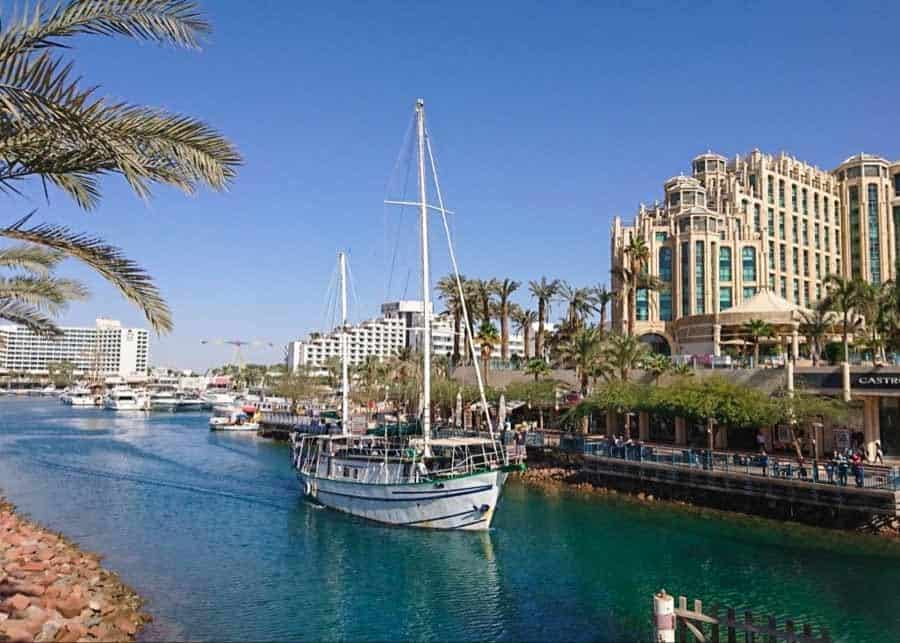
However, if you are not into water sports and beaches, you may not find Eilat very interesting. We’ve only spent a few hours here before heading to the Negev Desert.
About 25 km north of Eilat we stopped to visit Timna Park, one of the biggest attractions in southern Israel. The Negev Desert is famous for its jagged landscape and red-colored rock formations, but also for its copper ore.
Since Timna was the center of metal production in the ancient world, many historians believe that King Solomon’s Mines were actually here.
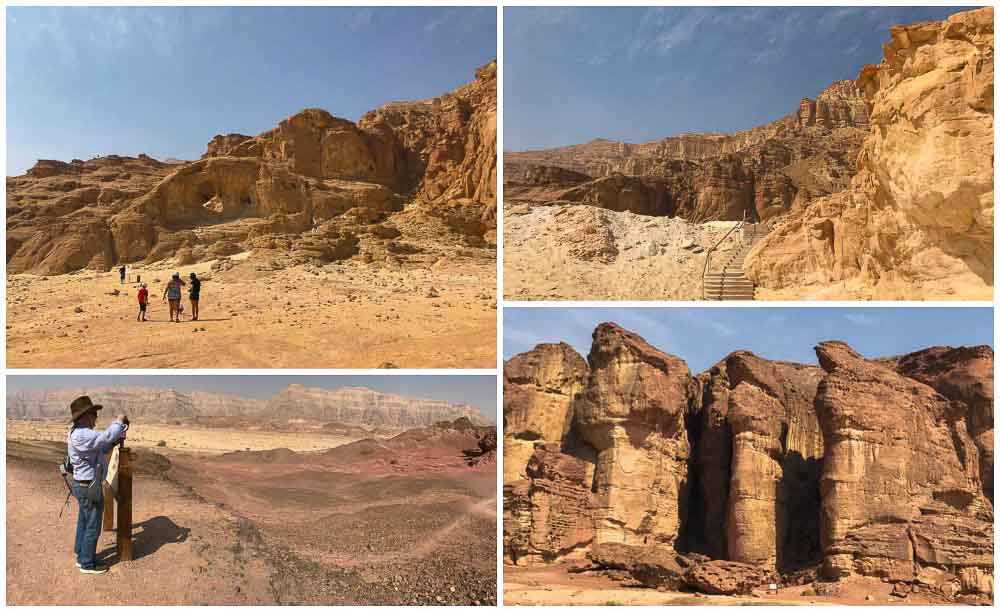
The park is quite impressive and has endless beautiful trails to enjoy. Unfortunately, when we visited Timna it was too hot for hiking. We only drove around and stopped at the different points of interest.
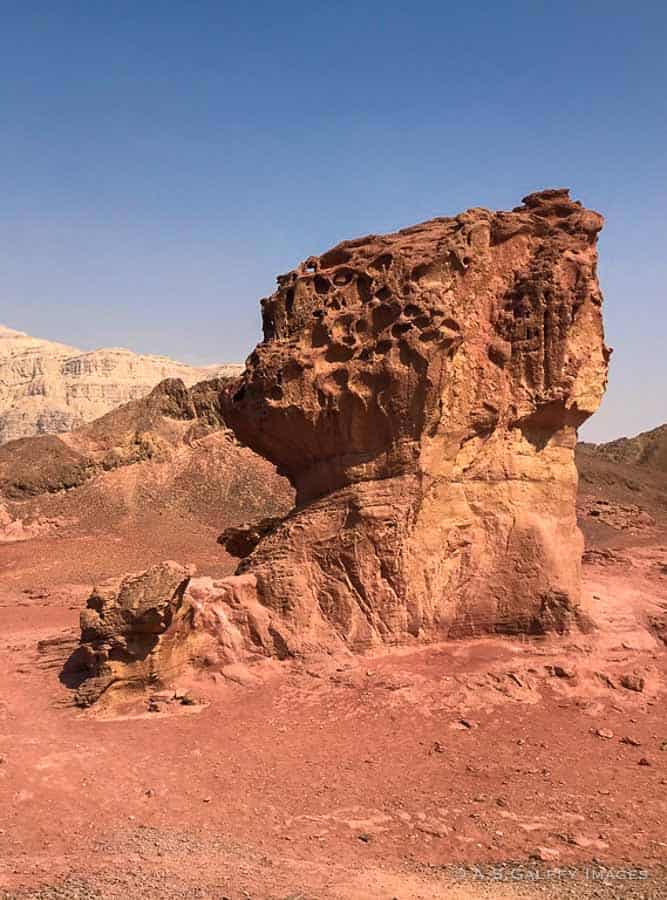
For those acquainted with the Jewish history, Timna holds a very special surprise: a life-size replica of the biblical tabernacle, mentioned in the Old Testament. The tabernacle was the earthly dwelling place of Yahweh (God). During their 40 years of wandering through the desert, the Israelites carried the tabernacle with them.
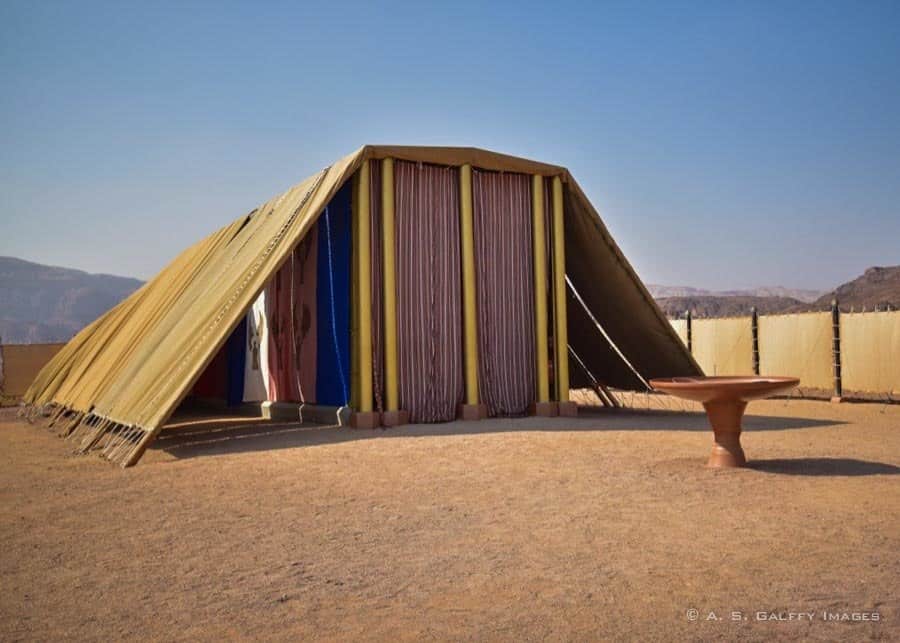
Day 2: West Bank (Bethlehem, Jericho & Qasr el Yahud Baptismal Site)
For Christians, Bethlehem and Jericho rank very high on the list of places to visit in Israel. Both cities have very strong ties to the biblical history. However, many people are nervous about visiting them because they are located on the West Bank, which is a Palestinian territory.
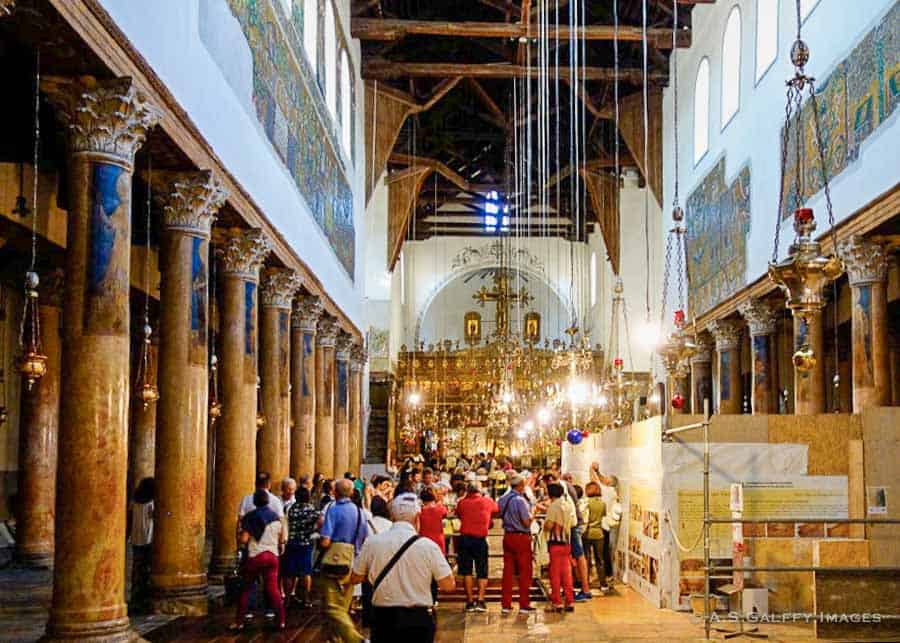
But no need to worry. Crossing over to the West Bank and back to Jerusalem is pretty safe. Bethlehem and Jericho are tourist-oriented towns and the Palestinian authorities go to great lengths to make them safe to visit. Just be sure you bring your passport with your Israeli-issued tourist visa to enter and exit the Palestinian areas.
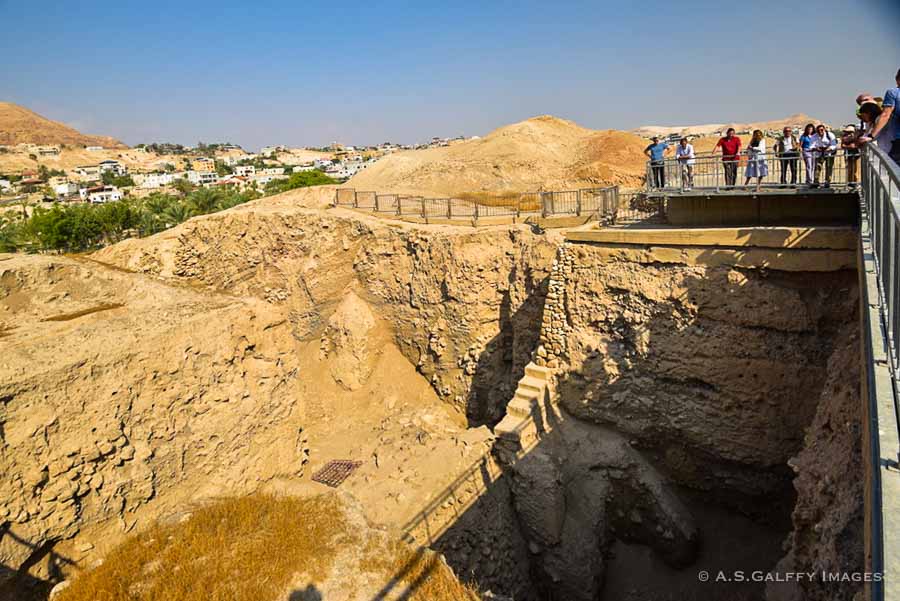
After visiting Jericho, we stopped the Qasr el Yahud baptismal site, another special and sacred spot for Christianity. This is believed to be the place where John the Baptist baptized Jesus, some two thousand years ago. Therefore, pilgrims from all over the world come here to be baptized in the very same spot on the Jordan River.
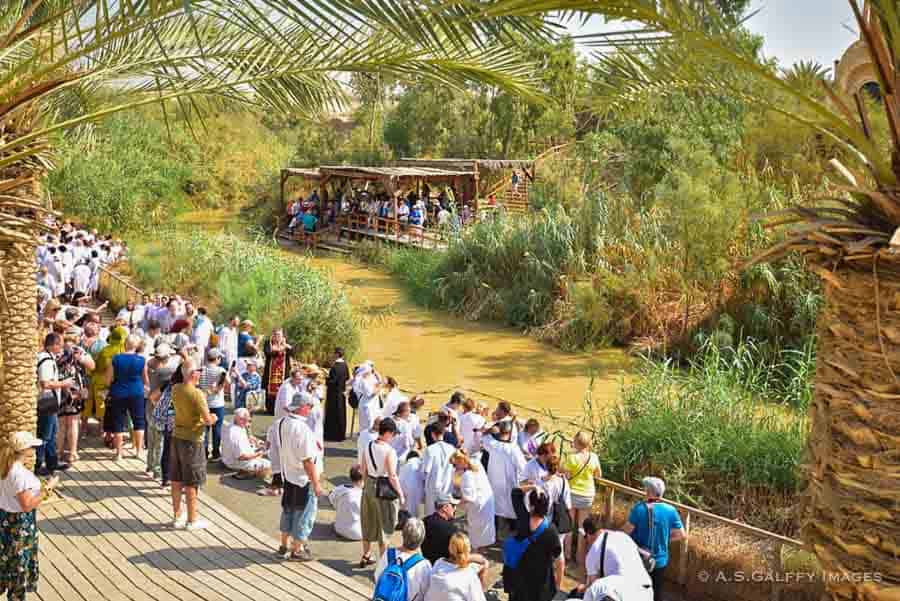
There are several companies that run tours to these locations with departures from different cities in Israel. Although many people travel to the West Bank independently, I think it’s wiser to take a tour or hire a cab to cross over. Many cab drivers in Jerusalem are Palestinians and know the ins-and-outs of the West Bank, so you’ll be in good hands.
Day 3: the Judean Desert (Masada & the Dead Sea)
On the third day of our itinerary we headed south towards the Judean Desert, where visited the famous fortress of Masada and soaked in the Dead Sea.
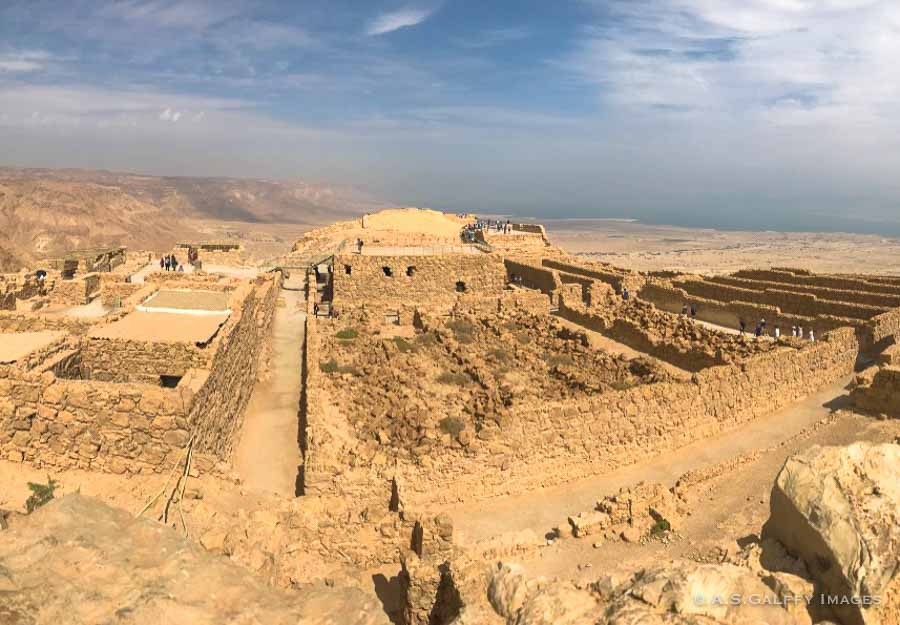
Masada
Of all the places we visited in Israel, the fortress of Masada impressed me the most. It wasn’t only its fantastic location, atop of large hill, but also its tragic story. The story of the Siege of Masada was told by Flavius Josephus in his writing “The Wars of the Jews.”
In his chronicle Josephus states that 967 Jewish Zealots retreated at Masada, with nowhere to run from the Roman army. The siege lasted for 3 years, but finally the Romans managed to gain access to the fortress. When they realized the situation, the Jews decided to die rather than be taken hostages.
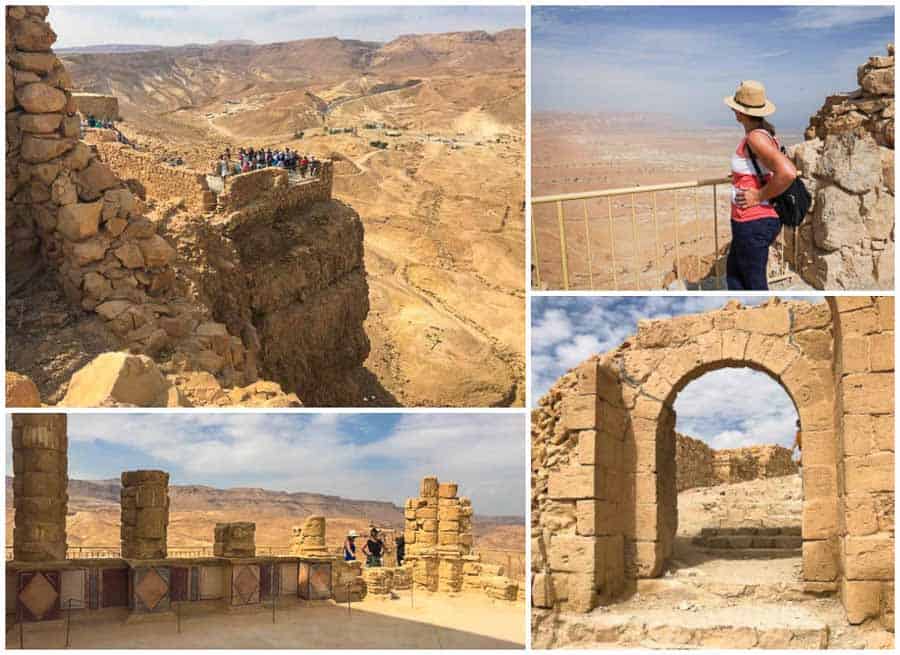
The Dead Sea
After visiting the fortress, we headed down to the Dead Sea to cool off and float in the super salty water. I think no trip to Israel is complete without a visit to the Dead Sea. This gigantic lake that spreads over miles, lies 430 m below sea level, which is the Earth’s lowest elevation on land.
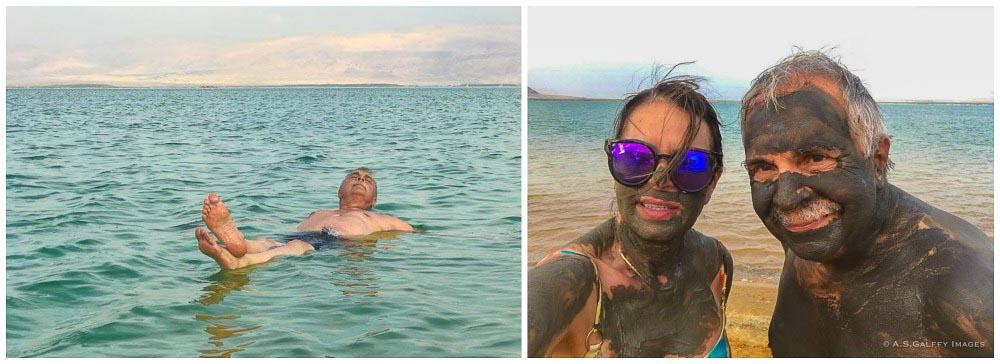
The Dead Sea is just 30 km away from Masada National Park, so it’s an easy drive if you visit the fortress first. Coming from Masada, there is a nice beach area with showers, umbrellas, and a restaurant. We stopped here to smear ourselves with some mineral-rich mud and soak in the warm, salty water.
Israel Itinerary Day 4 to 9: Jerusalem
We decided to spend 6 days in Jerusalem, since many of the important places to visit in Israel are actually here. Most of the guides I’ve read recommend spending 2-3 days in Jerusalem, but I thinks that’s not enough time.
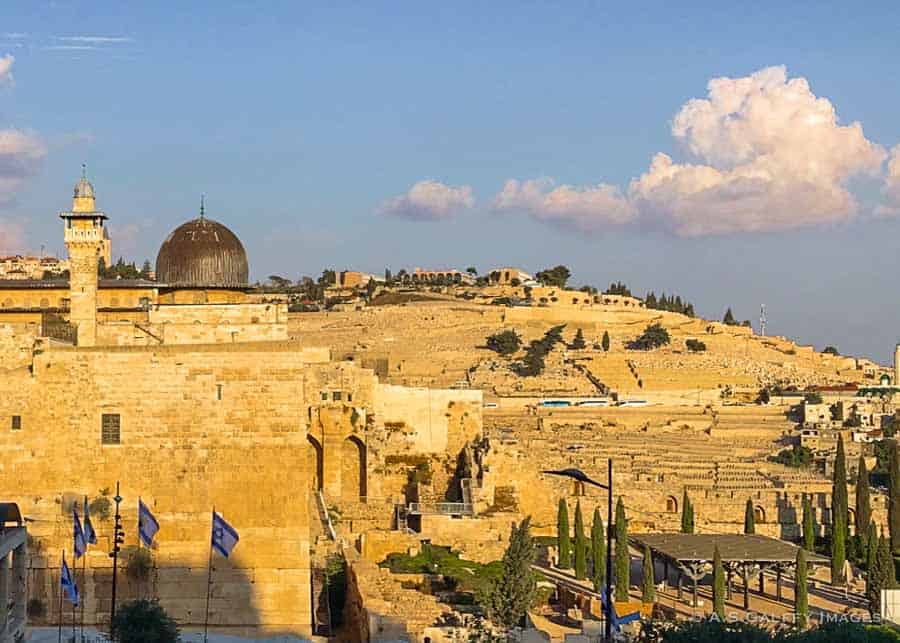
Although we had 6 days in Jerusalem, we still didn’t get to visit everything we would have liked to! In my opinion, 7 days would be the ideal amount of time for exploring the city.
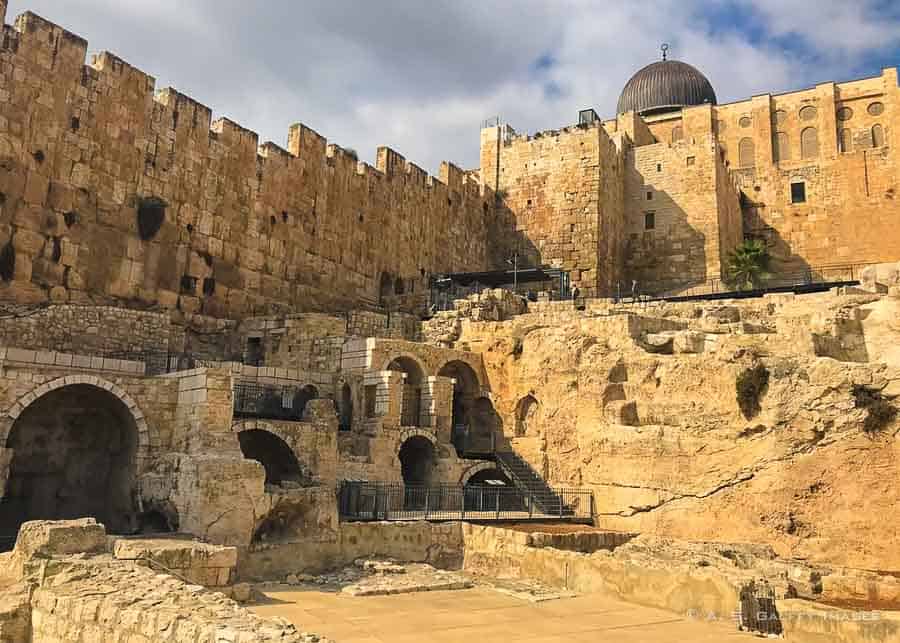
However, most visitors to Jerusalem can only spend two days there. If that’s your case, here is how can group the important sites:
On the first day you can visit the Mount of Olives, which is just across to the Old City walls. Here you can visited the Chapel of the Ascension and the Jewish Cemetery, then walked downhill towards the Old City.
Along the way you should visit the Dominus Flevit Church, Church of All Nations, Garden of Gethsemane, and the Tomb of the Virgin Mary. You can end the day visiting the City of David, an amazing archeological site that contains the oldest part of Jerusalem.
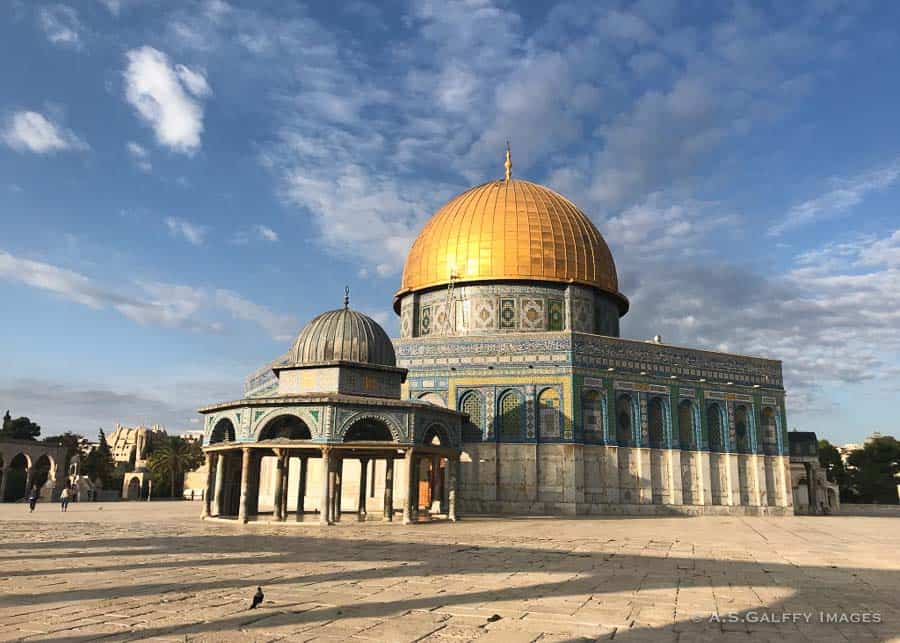
On the second day you can visit the sites located in the Old City. Those include the Church of the Holy Sepulchre, Temple Mount & Dome of the Rock, the Western Wall, Via Dolorosa, the Tower of David Museum, and the Ramparts.
Day 10 & 11: the Sea of Galilee
We’ve spent days 10 and 11 of our itinerary visiting the sites around the Sea of Galilee, which is the largest fresh water lake in Israel. The Sea of Galilee is one of the places you should visit in Israel, especially if you have an interest in Biblical history.
We stayed in Tiberias, which is the perfect base to explore the region. Tiberias has a few tourist attractions worth visiting. One is the Yigal Alon Promenade from which you can admire Lake Kinneret (Sea of Galilee).
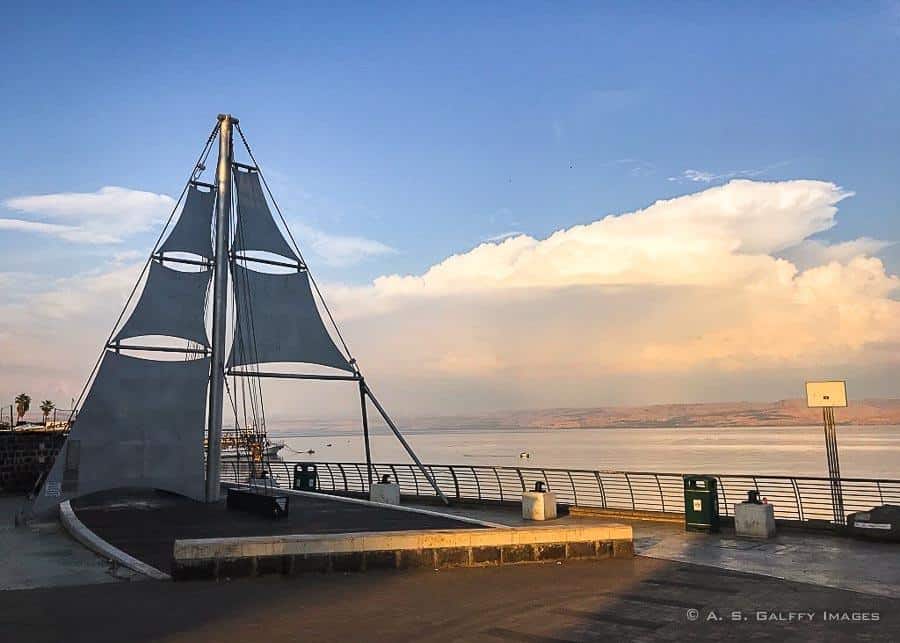
Tiberias is also home to a number of important Jewish tombs among which is the tomb of Maimonides, a great philosopher and physician who became Saladin’s personal physician.
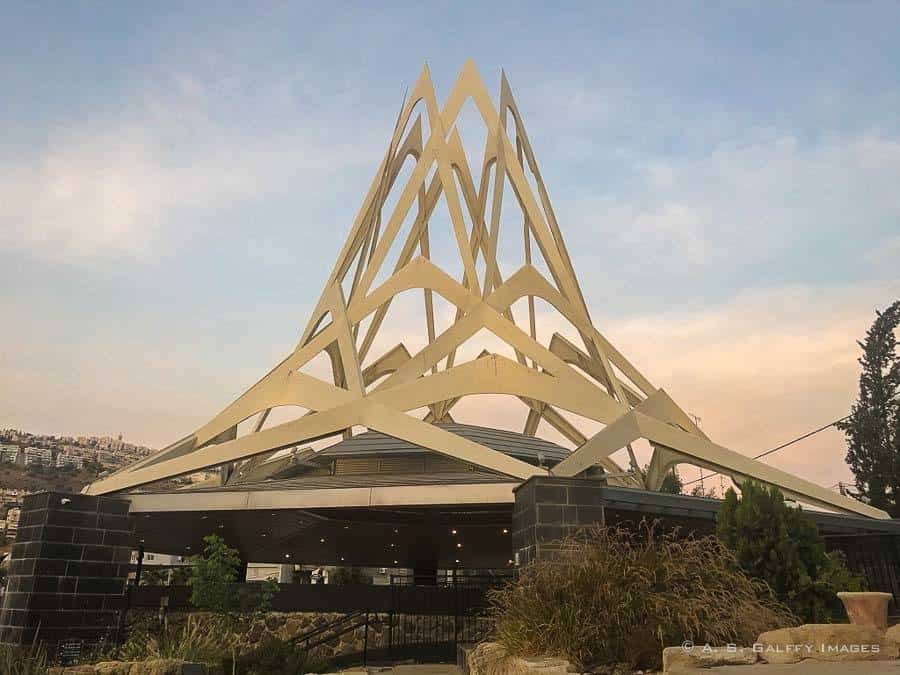
Around the Sea of Galilee there are several sites of great significance for Christians: the Church of the Primacy of St. Peter, built on the rock where Jesus told Peter “feed my sheep;” the Church of the Multiplication of the Loaves and Fishes; the Church of the Beatitudes, built on the place where Jesus gave the Sermon on the Mount.
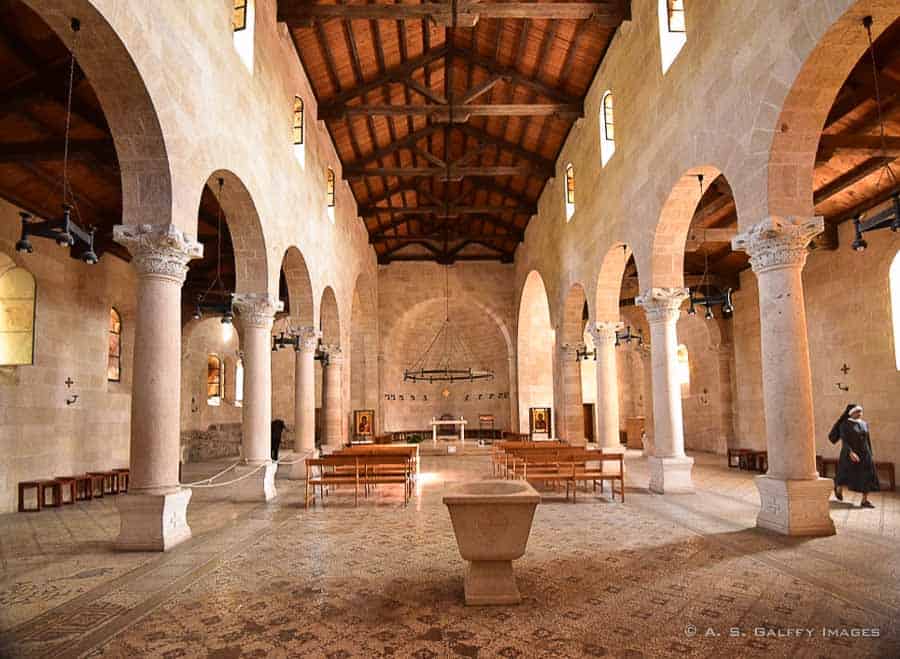
One site that I found pretty impressive was Capernaum, which is believed to be the fishing village where Jesus lived. It was also in Capernaum where he gathered the first of his disciples, Peter and Andrew.
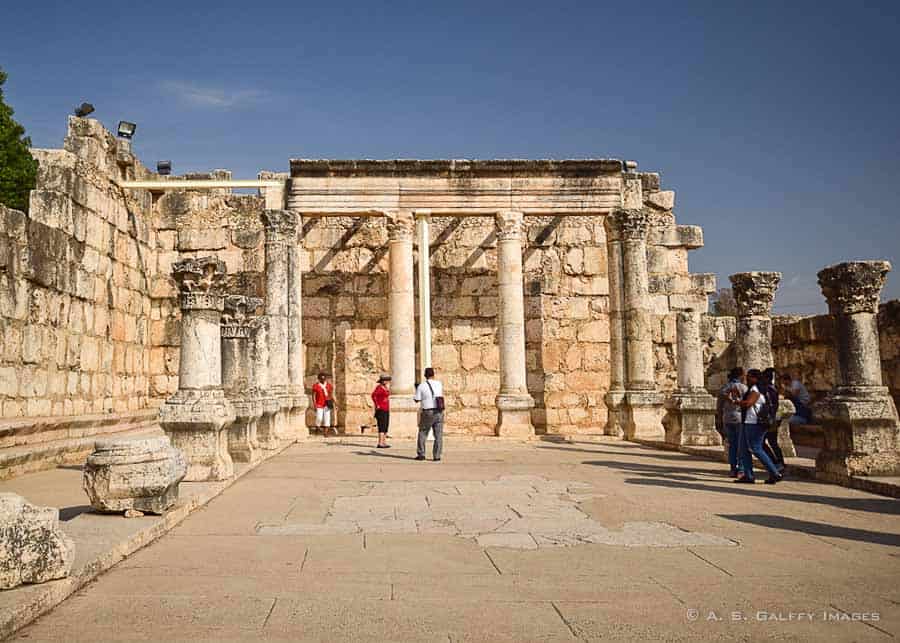
Another interesting site is Kibbutz Ginosar, where you can see the remains of a boat from the 1st century AD. This boat could have been in use during the time of Jesus.
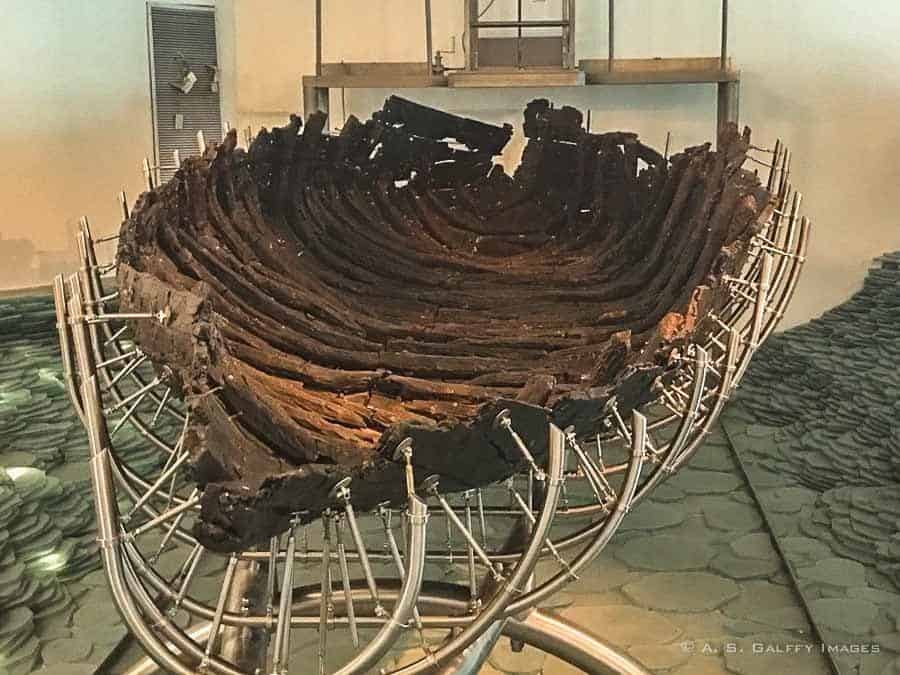
The Greek Orthodox Church of the 12 Apostles is a newer church (1925), well worth a visit. Its striking red domes can be seen from afar. If you have time to drop by, you’ll be rewarded with some beautiful frescos painted in very vivid colors.
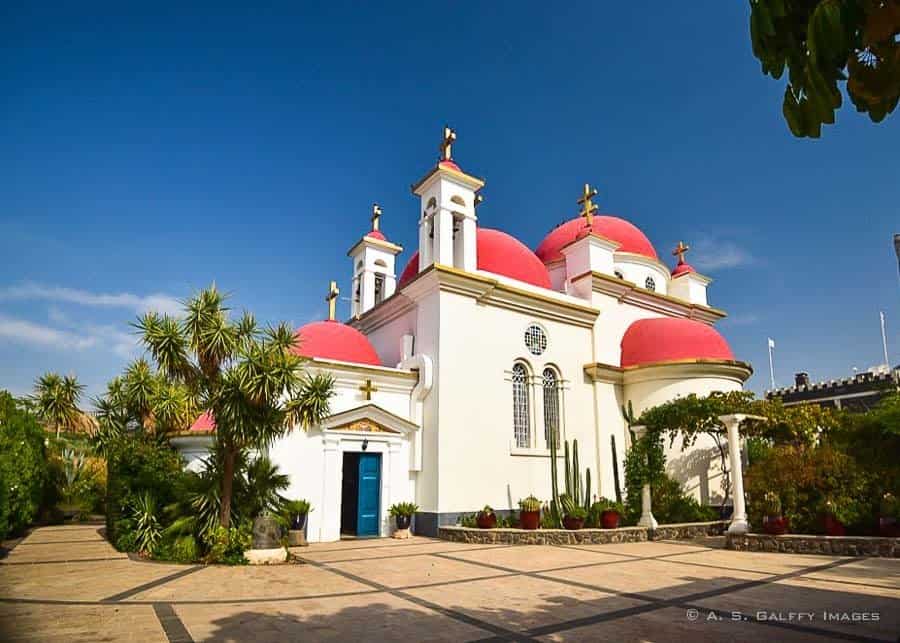
The basalt ruins of Kozarim are the remains of another town from the time of Jesus.
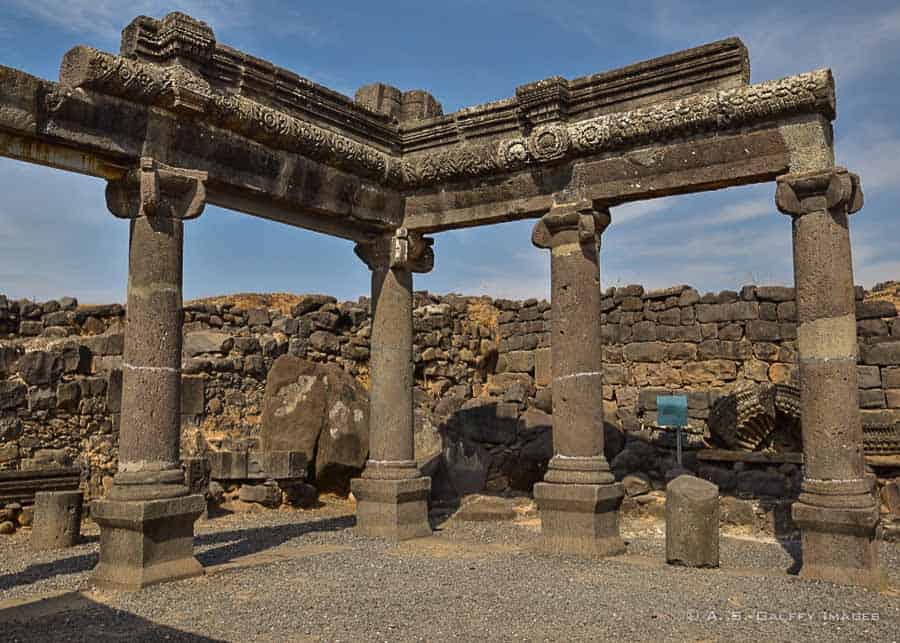
We’ve spent two nights in Tiberias, but we only needed one day to visit the sites around the Sea of Galilee.
Israel Itinerary Day 12: Nazareth & Akko
Nazareth
One site that you shouldn’t miss in Nazareth is the Synagogue Church, which belongs to the Greek Catholic Melkite community. According to Christian tradition, this is the place where Jesus declared himself as the Messiah in front of the entire congregation. His sermon infuriated the religious leaders so much, that they wanted to throw him off a cliff, but de mysteriously disappeared.
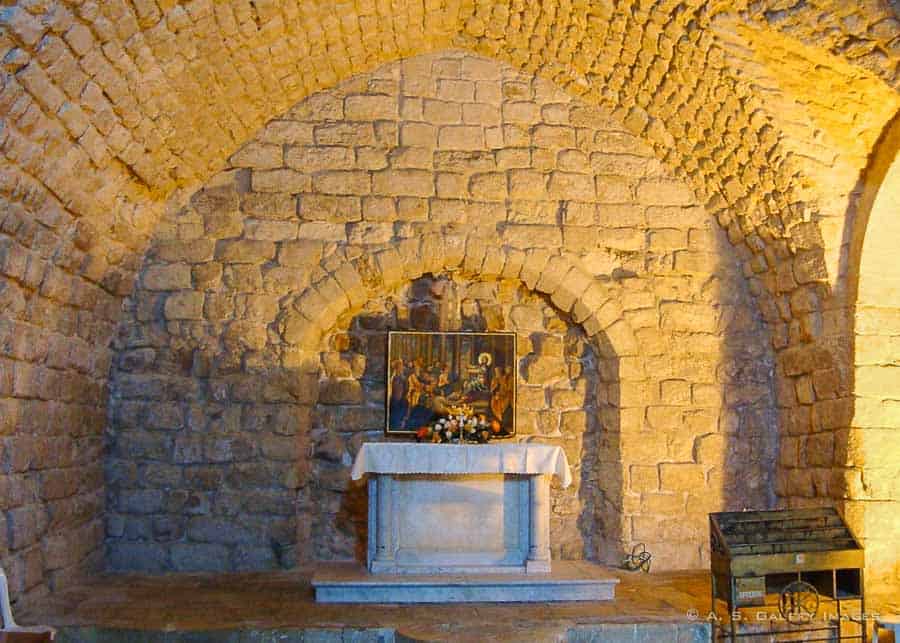
Another important Christian site is the Basilica of the Annunciation. They believe the church was built on the exact place where Mary received her message from God. As a result, Basilica of the Annunciation is regarded as one of the most important modern churches in Israel.
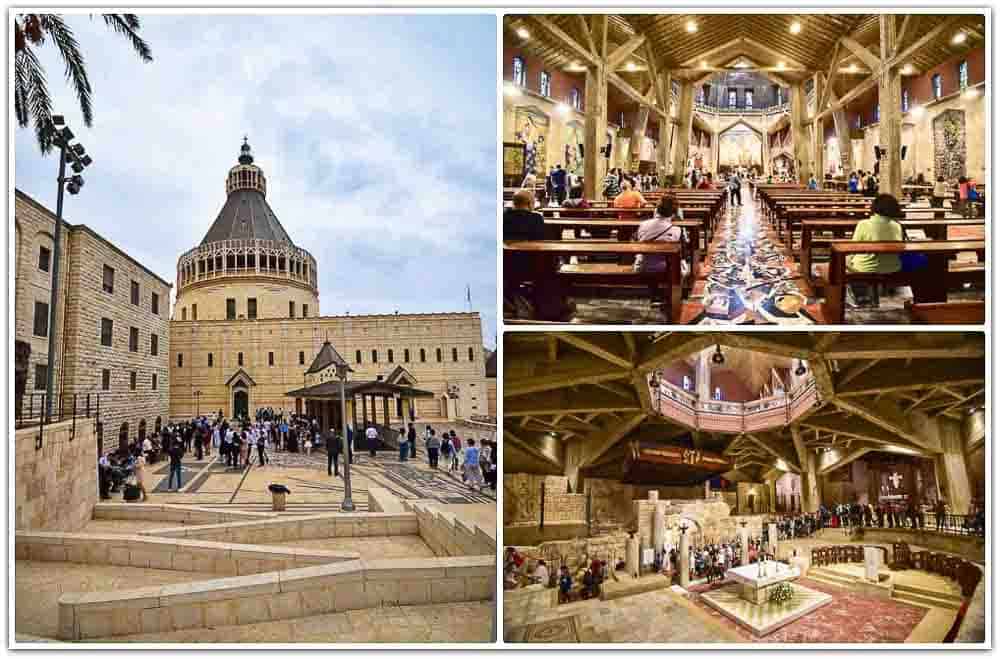
Very close to the Basilica of the Annunciation you can see St. Joseph’s Church, where it is believed Joseph’s carpentry shop was. The church has an underground cave that once served as a grain store.
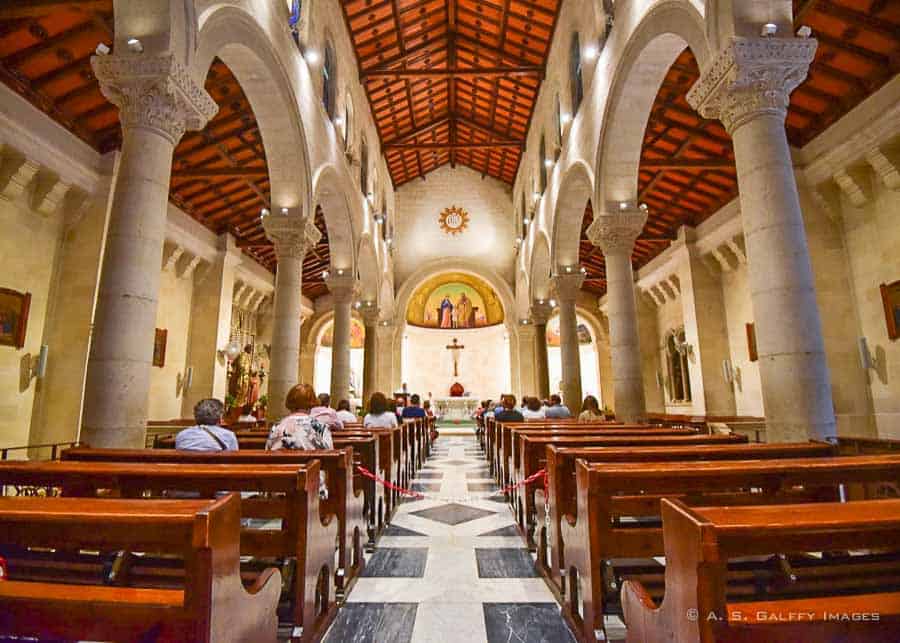
An interesting place to visit is the Nazareth Village. This is in an open-air museum where Biblical stories are reenacted with live animals and people dressed up in historical costumes. Unfortunately the village was closed on the day we were in Nazareth, so we couldn’t see it.
Akko (Acre)
Akko (also known as Acre) is a 4000 years old city that changed hands many times over the course of time. Acre had a tumultuous history that was influenced by the Romans, Ottomans, Crusaders, Byzantines, and British. You can still see the remains of the Crusader town, as well as the walls, mosques, and baths, from the Ottoman period.
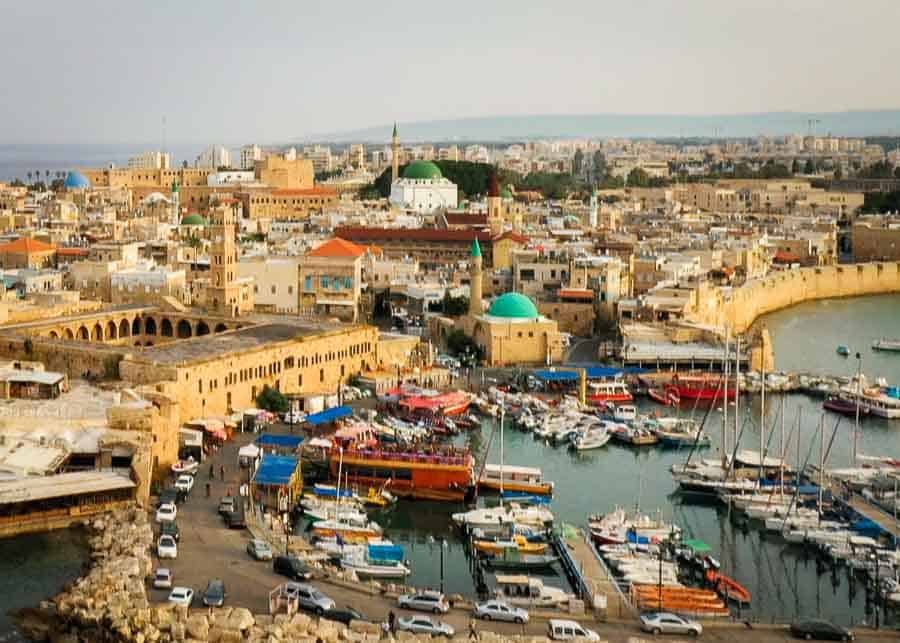
If you have time, I would recommend spending an entire day in Acre. The old city is an interesting mix of archeology, open-air markets, and fishing port. One of Akko’s biggest attractions is the Hospitaller Fortress, where you can wander through enormous stone rooms with vaulted ceilings.
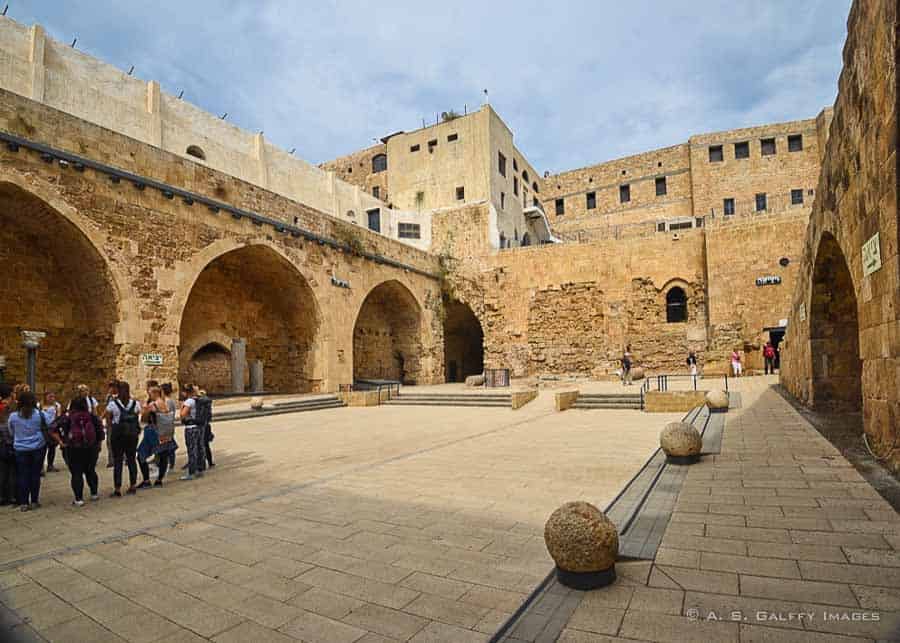
Acra it’s easy to explore and you don’t need more than a day here. The city makes an easy day trip from Tel Aviv.
Day 13: Haifa & Caesarea
Haifa and Caesarea can be easily visited on a day trip from Tel Aviv, as they are only an hour away from the city.
Haifa
For some reason Haifa is not always on the list of places to visit in Israel, although it enjoys a spectacular location, on the shore of the Mediterranean Sea. There are some nice spots in Haifa that are worth visiting. One is the Baha’i Gardens, a series of 19 terraced gardens located on the slopes of Carmel Mountain. From the top of the gardens you have a fabulous panoramic view of the entire port area.
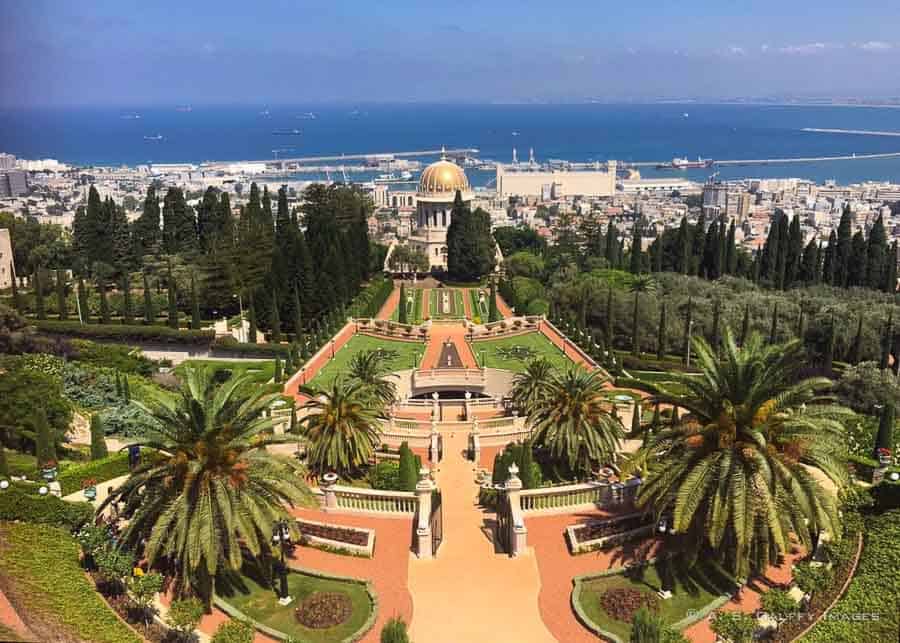
Other interesting sites we visited in Haifa were Elija’s Cave and Stela Maris Monastery, which was erected on Mount Carmel – the spot where the Prophet Elijah fought the prophets of Baal.
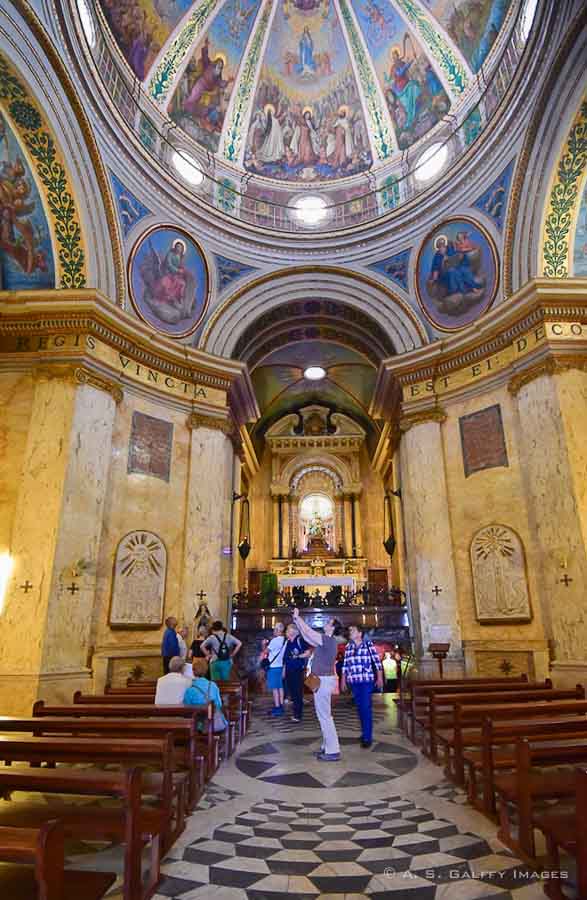
Caesarea
Caesarea National Park is one of Israel’s most impressive archeological sites, but it’s difficult to visit without a car. This grandiose port city was erected by Herod the Great in 21 B.C.
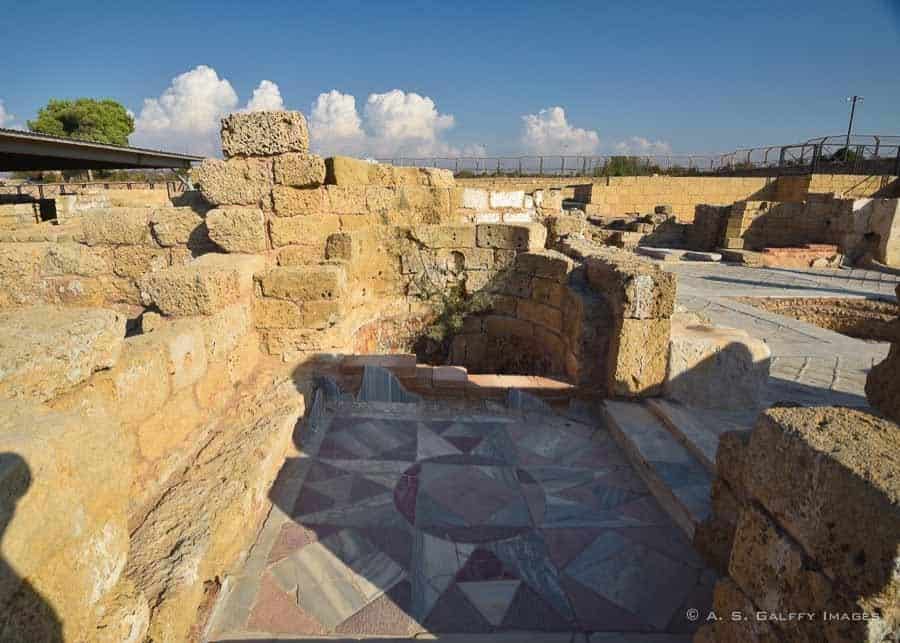
There is so much to see in Caesarea: an amphitheater, some baths, a hippodrome, and the port. One thing not to miss when exploring the site is the limestone block in the theatre on which the name of “Pontius Pilatus” is inscribed. This is the first archeological proof that he existed.
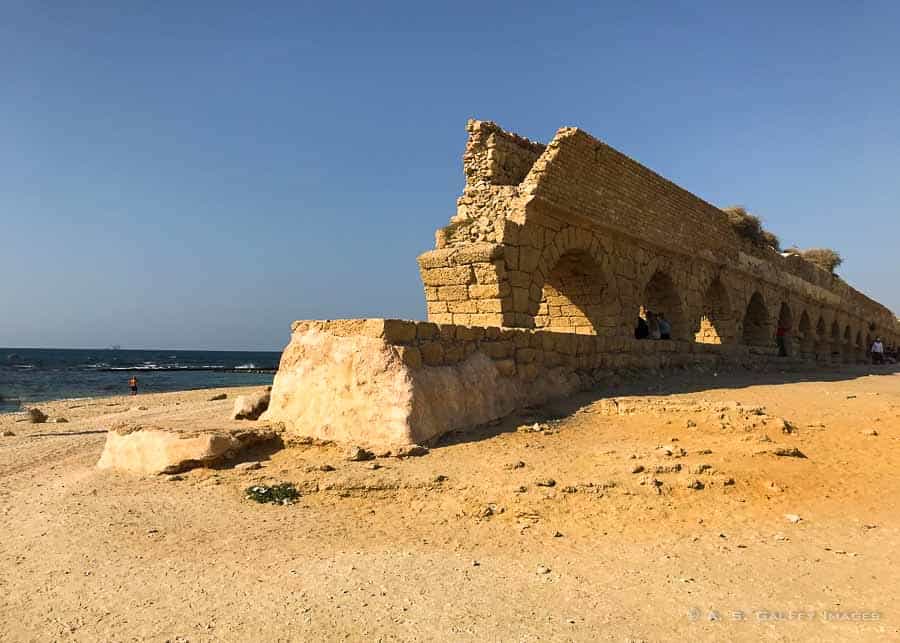
A little further north, outside the archeological park, you can visit the ruins of an ancient Roman aqueduct.
Day 14 & 15: Tel Aviv & Jaffa
We ended our trip to Israel in Tel Aviv, where we stopped for two days before returning to California.
Tel Aviv is very different from all the other places you’ll visit in Israel in the sense that it’s very liberal and more wealthy. This beachfront city is Israel’s largest metropolitan area, so you’ll find no shortage of entertainment.
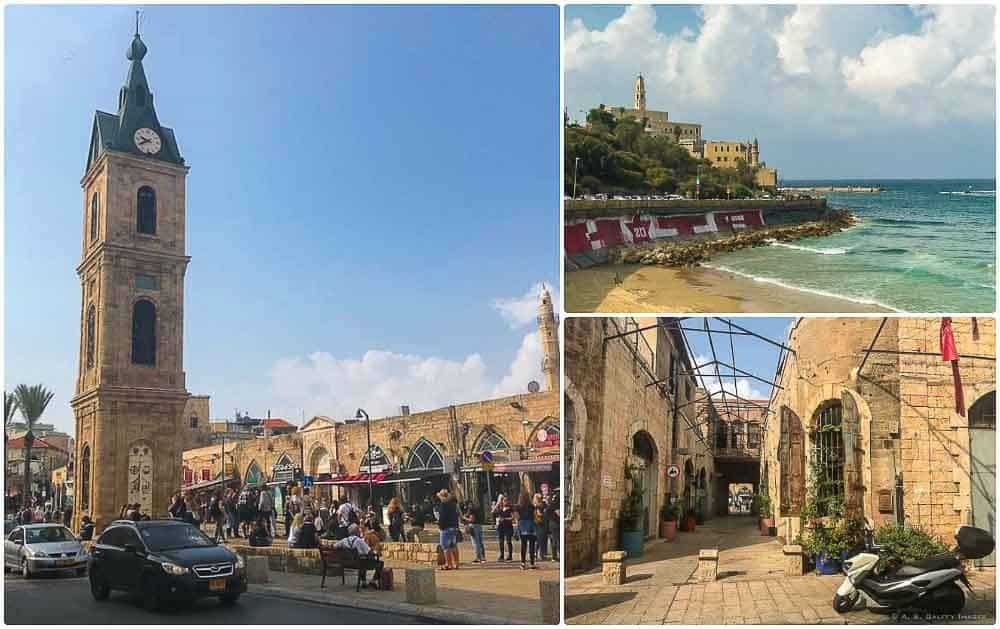
The best part of Tel Aviv in my opinion is the ancient port of Jaffa, out of which the modern city has actually grown. Although the port is no longer used by larger vessels, small fishing boats still go in and out every day. Jaffa looks a little run down, but we still enjoyed walking around the alleyways and exploring the markets and galleries.
Day 16: Fly back home
We didn’t have much time for sightseeing on our last day. We departed for the Ben Gurion airport in Tel Aviv about 5 hours before our flight. Getting in and out of Israel is a hassle, so we wanted to make sure we won’t miss our flight. 16 days flew by so quick that we couldn’t believe it!
When is the best time to visit Israel?
Weather is an important factor to consider when planning your trip to Israel. The best time to visit Israel depends on the type of trip you are planning. If you you looking for a religious heritage-themed trip, like we did, you should consider going during the cooler months (November to March).
We traveled to Israel in late October, hoping the weather would be cooler and more pleasant for walking. However, with very few exceptions, it was mostly hot and humid (28-35ºC). The good part about traveling in October was that days were still long, so we could spend a lot of time outside.
Questions about this Israel Itinerary? Leave me a comment below. You can also pin this for later.
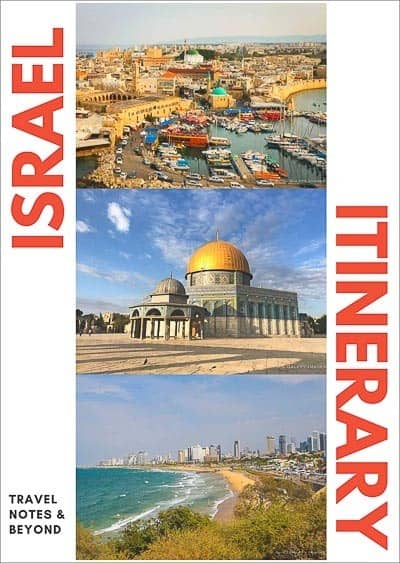

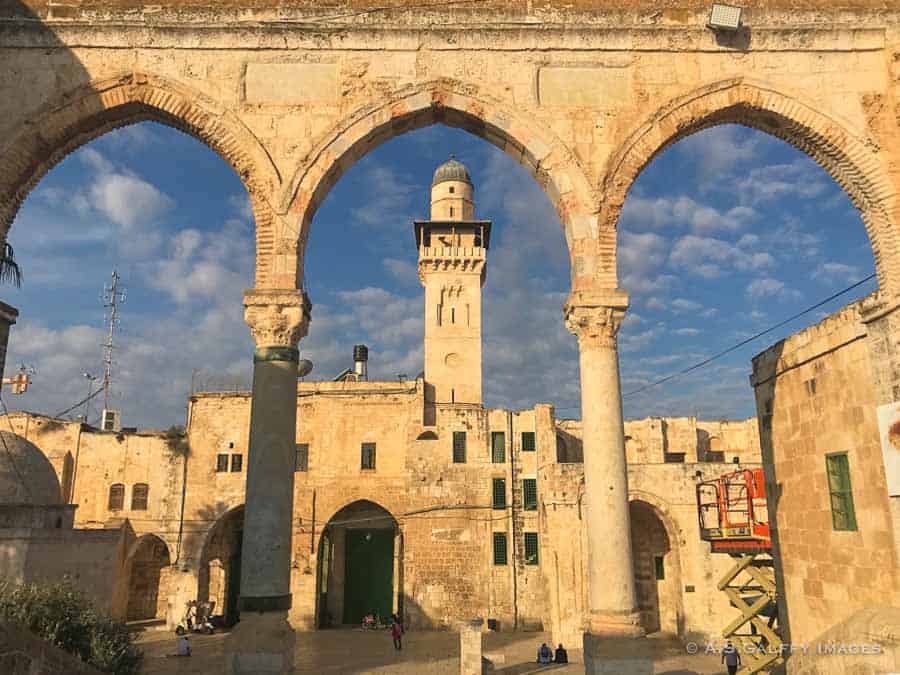
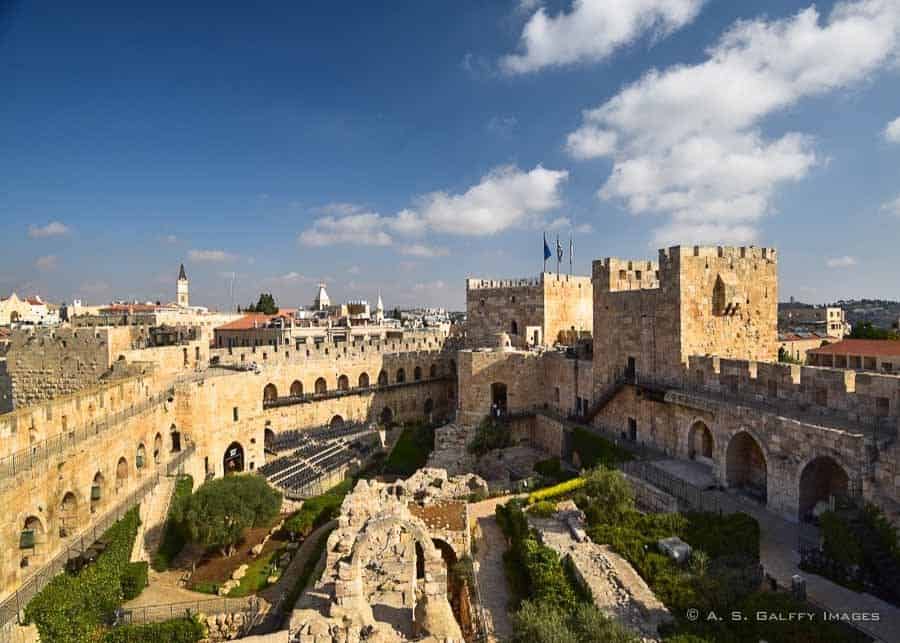 23 Historic Places to Visit in Jerusalem Old City
23 Historic Places to Visit in Jerusalem Old City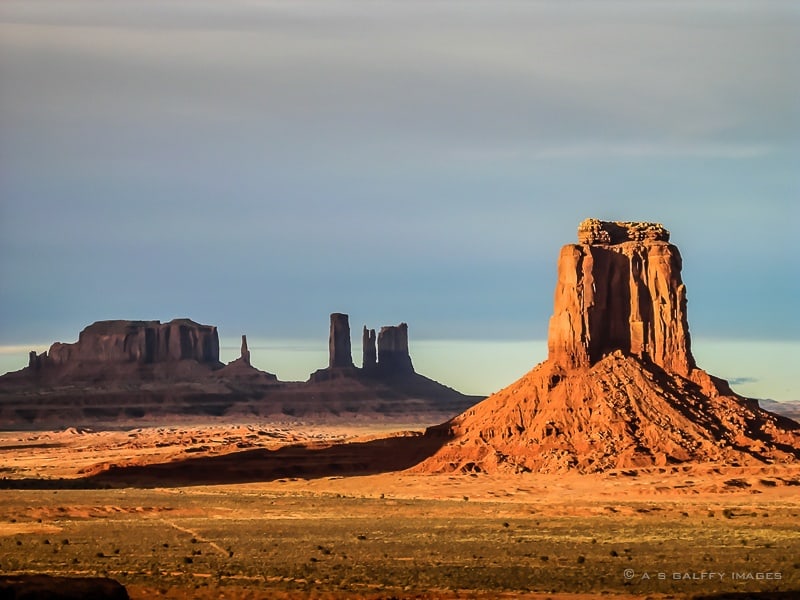



Steve
Question is: Wife and I are trying to figure out a 2 week trip to Israel maximizing visit is to biblical sites, doing it safely and having a great time. We want this reservation to include flights to and from New York, accommodations in top notch quarters in Israel, best food, and experience worth bragging about.
How much is the package?
Anda
Unfortunately I can’t help you with this information, Steve. I am not a travel agency, I only provide information about the destination. However, you may check my travel resources page for the beast deals on airfare and hotels.
Dallice Lazarus
This sounds great. This will be our third trip but different as this time it’s just my husband and myself. We do want to cover most of what you did. We have to start in Eilat then go back to Tel Aviv for a wedding. Do you think that’s a reasonable plan? Eilat Masada Dead Sea Tel Aviv and then Jerusalem?
Anda
It sounds like a reasonable plan, depending on how much time you you’ll have in Israel. The country is not very big, as you probably notices during your previous trips. Many of these places can be visited as day trips. We spent two weeks on this itinerary, but we wanted to allow ourselves enough time to visit the sites. Hope this helps.
Steven
Hi: Many sites and videos give key places to visit, but it is much more difficult to gain insight into traveling between those locations. In one sense, easier to just be on a large tour. That of course, restricts you to a frigid timeline and strips out any ability to just stop and enjoy a moment a time longer at any one location, or to see other complimenting sites near by the primary visits. The advantage is getting into certain sites is clear as many key sites are geared toward accommodating tour groups. The whole issue of bag drag between different locations and where to store your items, combined with the hassles of public transport from one place to another (Ex: Tel Aviv to Acre – but seeing some sites in Caesarea and Haifa enroute). Time dedicated to the logistics competes with time actually spent seeing locations of interest. Any suggestions on balancing the competing events or where to look to gain greater insight? Thanks
Anda
Hi Steven,
We visited Israel by car and believe that’s the most convenient way to travel between the sites. From what I know there are companies that organize longer tours, so if you go with them you won’t have any issues with luggage logistics. However, since I have no experience with tours in Israel, I can’t give you any advice concerning that.
Dennis Drake
Love your posting and suggested 2-week itinerary for Israel!
We’re older American-types and are wanting to know your thoughts on safety especially with recent new reports. Are there places where we’d be better off avoiding right now?
Anda
Hi Dennis,
We felt pretty safe in Israel, everywhere we went. We even visited Bethlehem, on the Palestinian side, and didn’t encounter any problem. However, given the current situation, I would probably avoid the Palestinian side. If you decide to go anyway, book a guided tour, don’t go on your own. There are many Muslim drivers in Jerusalem who will offer to take you there, but it’s better if you go with an organized tour.
Mark Sanders
Great information and looks amazing. Could you give us some insights for places to stay during our visit to Israel?
Thank you
Anda
We stayed at the St George’s Pilgrim Guest House, which was very conveniently located just outside the city walls. It was a nice, clean place that also had a restaurant on the premises. Some friends of ours stayed at The Sephardic House Hotel in the Jewish Quarter, and were very pleased with it too. When we visited Tel Aviv we stayed in Jaffa, at the Casa Nova Boutique Hotel. That was rather expensive but had gorgeous water views. We also stayed in a couple of other small hotels during our trip, but I can’t remember their names. Hope this helps.
Yukti Agrawal
Israel looks worth visiting for those ancient historic monuments and everything here looks like we have entered into its glorious past. I would also combine it with Jordan trip as you said we can cross borders in Eilat. From Eilat I will also love to visit the Negev Desert, the Dead Sea, Jerusalem, the Sea of Galilee, Akko, Haifa, and end trip in Tel Aviv in the same pattern which you did as it looks very beautiful itinerary. Akko – Acre a 4000 years old city that has influence of Romans, Ottomans, Crusaders, Byzantines, and British looks very interesting to me.
MEENAKSHI J
I love exploring every destination on my own and I am glad you too enjoy the same. This post brings back memories of my husband’s Israel trip. He had stayed there on work for almost two weeks, yet, hardly saw anything listed here! As you rightly put forth- there are not many well-curated itineraries for a self-guided tour of Israel, online. thanks for putting together this comprehensive post. It definitely is gonna come handy 🙂
Anda Galffy
You are welcome, Meenakshi. Hope you and your husband will get to visit Israel soon.
Jackie
Great itinerary for Isreal and I especially like that you included Baha’i Gardens. So many of these stops are personally meaningful to me…I would want to take time in the gardens to reflect upon them all while enjoying such a beautiful view of the sea. Thanks for putting together this informative resource. Bookmarking for future reference!
Paula
Wow! You definitely saw a lot on this trip. We enjoyed Eilat as the Red Sea is beautiful, and snorkling there is great. But we ended up missing many of these beautiful cities on your list. We made it to the Dead Sea, Jerusalem and to Petra in Jordan, but I wish we would have been more brave and just toured bu ourselves like you did. Oh well, this just mean I have to go back. I wont complain.
Anda Galffy
Touring on your own surely has its advantage, but it’s not easy.
Jane Dempster-Smith
We are considering visiting Israel next year so your itinerary planning article is timely. We had not thought about a self-drive, but it sounds feasible especially since we don’t want to rush visiting Israel. We may have to rethink the month of travel after reading your tips. The Dead Sea visit looked fun.
Anda Galffy
Driving is not exactly easy in Israel, Jane. Especially getting in and out of the big cities. However, it’s the best way to visit the country. Hope you’ll make it to Israel soon.
sherianne
I would also visit Jordan first and start from Eilat, I’ve heard really good things about the area. It would be interesting to see the tabernacle in Timna. I took a tour to Israel and we were not allowed to enter Bethlehem or Jericho, I was very disappointed. I also loved Caesarea but your itinerary makes me realize how much I missed, I need to return and spend more time in Jerusalem and Tel Aviv.
Anda Galffy
When did you take that trip, Sherianne? It’s entirely possible to visit the West Bank these days.
Danik
Fantastic guide here Anda and there are places on this list I have never even heard off such as Haifa and Caesarea. I would love to see the historical sites in that national park. I have been to Israel before but only did Tel Aviv, Jerusalem and Bethlehem. Would love to go back again,
Anda Galffy
Hope you will,Danik.
Laura Axtman
This itinerary is so helpful! Planning a trip to a faraway land leaves many questions. Thank you for explaining the safety aspects as well as the beautiful history I can explore during my travels. A day in Acre sounds like something I would love and a great way to learn about an important piece of Isreal’s history!
Rhonda Albom
I have wanted to visit Israel for a long time but did not know where to begin. I know there is a lot of history and you’re itinerary seems to cover it. Thanks for the tips on how much time to spend in each area. I like to pack a lot into my travel days but I don’t want to miss things due to lack of time. The reenactments at Nazareth Village sound great so I’ll be sure to be there on a day it’s open.
Anda Galffy
Thanks for dropping by, Rhonda. Hope you’ll visit Israel soon.